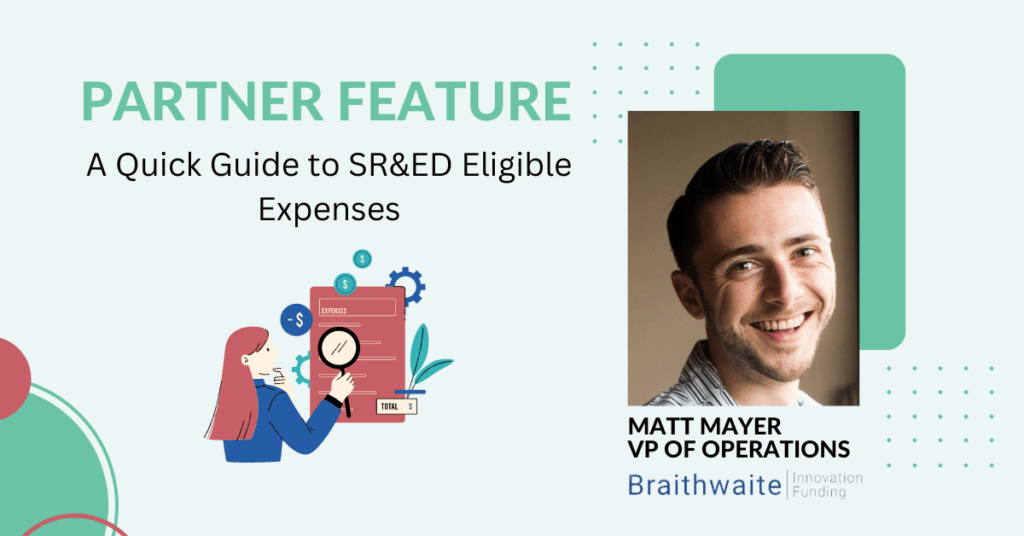Reading time: 5 minutes.
The Scientific Research and Experimental Development (SR&ED) Tax Credit is one of the oldest and well sought-after credits provided by The Canada Revenue Agency (CRA) across Canada. With over 20,000 claims filed yearly valued at more than four billion dollars, the SR&ED Tax Credit is fundamental in creating jobs, building new facilities, and expanding operations. The program’s lofty goal is to make Canada one of the leading innovators in the world. However, there is still confusion among claimants on what expenses are eligible, leaving many dollars on the table due to common mistakes. This article assists first-time filers as well as long-standing filers on how to identify and maximize your SR&ED Tax Credit Claim.
Eligible SR&ED Expenses
- Full-time and part-time employees in Canada (T4).
- Subcontractors located in Canada
- Materials consumed (IT/Software excluded)
- Collaboration with Universities and/or Colleges
The main eligible SR&ED expenses that qualify for a claim are employees and subcontractors within Canada. The goal of the credit is to keep innovation within Canada by rewarding companies employed within Canada. Depending on your company’s industry, two lesser-known expenses tend to get overlooked. If your company, as an example, is in the manufacturing industry, materials consumed that are directly involved with the SR&ED project(s) qualify. For many companies, this can be thousands if not millions of dollars in consumed materials. For example, if you are in the pharmaceutical field, you may have collaborated with a College or University on a project (clinical trials). These expenses, which need to show an invoice, are eligible to claim with the SR&ED Tax Credit.
Now that we have outlined the main eligible SR&ED expenses let’s look at overlooked criteria possibly affecting your company’s SR&ED return.
Overlooked SR&ED Criteria
CCPC vs. Non-CCPC
Many companies in the SR&ED program can become confused with CCPC versus Non-CCPC status when there has been a change in ownership. CCPC stands for Canadian Controlled Private Corporation. To remain a CCPC within Canada, a company must maintain a private corporation with taxable capital under $50 million.
Why is this so important?
A CCPC company is eligible for a 35% cash refund from the Federal Government. If the company is Non-CCPC, it will receive a 15% tax credit that it can utilize for the next 20 years. This difference is enormous as one is a cash return, and one is a credit return. We have seen companies in the past think they are a CCPC, but there are associated companies or a change in ownership affecting the change in the company’s status.
Support Work
As we mentioned, employees and subcontractors directly involved with the SR&ED project(s) are eligible to claim. However, there is an area within the Tax Credit to claim support work. Support work cannot be claimed on its own, but it needs to be proven that it is directly involved with the SR&ED project(s). Some examples of support work that are eligible are testing, data collection and design work.
R&D Job Title & Working 100% on SR&ED
There is still the notion that men and women in white lab coats or that have scientific titles are the only ones that companies can claim under the SR&ED Tax Credit. This concept can’t be further from the truth as every industry across Canada can apply for the credit as long as the company seeks technological or scientific advancements. There is also the common misconception and often overlooked employees involved with the project(s) but because they do not spend 100% of their time on innovation, sadly go unclaimed. Even if an employee spends only 10% of their yearly time during the eligible fiscal year end on the eligible project(s), their time qualifies.
Documentation
A company can have the most innovative project the world has ever seen, but if there is no proper documentation with T4s, subcontractor invoices, and material invoices, sadly, the CRA will reject its claim. Proper documentation can be in the form of timesheets, software platforms breaking down SR&ED costs vs. regular working hours, emails, notebooks, drawings, etc. The CRA does not require this documentation on the initial claim submission, but the CRA will request this information if an audit is triggered.
The Importance of An SR&ED Consultant
Choosing the right SR&ED consultant is one of the most important financial decisions a business can make. A good partnership will result in successful claims year after year. Consider what attributes are important to you. If it is automation, gathering contemporaneous documentation, a consultant who has filed many similar claims, or a specific pricing structure, ensure you consider all variables closely.
An accurate claim verified by an SR&ED consultant will also help if that business intends to finance its claim. An SR&ED financing company like Venbridge will look more favourably on your financing request with the backing of a seasoned SR&ED consultant.
Fortunately, many exceptional consulting and accounting firms like Braithwaite can help you. Our experienced team offers tailored services to increase SR&ED returns, lowers time spent on SR&ED writing and allows companies to use their time wisely on research and innovation.
Braithwaite’s engagement process involves several steps. The most crucial step is identifying SR&ED projects occurring within an organization. With our strong technical base, Braithwaite can predict, on a very accurate basis, the likelihood of whether a project qualifies for SR&ED tax credits through a free consultation.
Matt Mayer – VP of Operations, Braithwaite
Since 2013, Matt has managed operations for all Braithwaite locations (Canada, Ireland and the UK).



